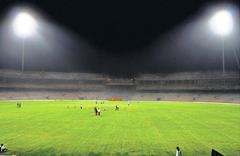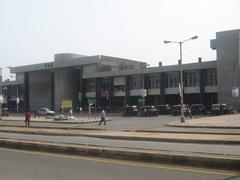Taloja Panchnand Railway Station: Visiting Hours, Tickets, and Comprehensive Travel Guide to Navi Mumbai’s Historical Sites
Date: 04/07/2025
Introduction
Taloja Panchnand Railway Station is a pivotal transit hub in Navi Mumbai, seamlessly connecting commuters, industrial workers, and visitors to various parts of the metropolitan region. As an integral part of the city’s planned infrastructure, the station not only supports daily travel but also anchors the dynamic socio-economic environment of Navi Mumbai. This guide delves into the station’s historical evolution, operational details, and role in the broader urban framework, offering practical information on visiting hours, ticketing, accessibility, and nearby attractions. Whether you are a commuter, a history enthusiast, or a tourist, this article aims to enhance your understanding and experience of Taloja Panchnand and its surrounding cultural landscape (E3S Web of Conferences; Liases Foras White Paper; MagicBricks; I Love Navi Mumbai).
Contents
- Introduction
- Historical Background
- Origins of Navi Mumbai’s Rail Network
- Development of Taloja and the Panvel–Karjat Corridor
- Timeline and Key Milestones
- Visiting Hours and Ticketing Information
- Urban Integration and Transit Connectivity
- Local Culture & Community
- Nearby Attractions and Photographic Spots
- Practical Tips for Visitors
- Frequently Asked Questions (FAQ)
- Conclusion
- Sources
Historical Background
Origins of Navi Mumbai’s Rail Network
The genesis of Taloja Panchnand Railway Station lies in Navi Mumbai’s visionary urban planning initiated in the 1970s to relieve congestion in Mumbai Island City. The City and Industrial Development Corporation (CIDCO) was established in 1970 to develop a well-organized satellite city, where transport infrastructure would serve as the backbone for self-sustaining nodes (E3S Web of Conferences; Slideshare).
Development of Taloja and the Panvel–Karjat Corridor
Taloja, initially recognized for its industrial significance, was strategically selected due to its proximity to major highways, industrial estates, and proposed mega-projects like the Navi Mumbai International Airport (NMIA). The development of the Panvel–Karjat suburban rail corridor, on which Taloja Panchnand sits, was crucial for facilitating both passenger and freight movement, supporting the Maharashtra Industrial Development Corporation (MIDC) and Jawaharlal Nehru Port Trust (JNPT) (Liases Foras White Paper).
Timeline and Key Milestones
- 1980s–1990s: Establishment of Navi Mumbai’s industrial and residential nodes, including Taloja and Panvel (Slideshare).
- 2000s: Panvel–Vashi suburban corridor commissioned; Panvel–Karjat extension planned.
- 2010s: Taloja Panchnand becomes operational, serving as a critical link for commuters and industrial workers.
- 2020s: Integration with the upcoming Navi Mumbai Metro Line 1 and nearby mega-infrastructure projects like NMIA and the Virar–Alibaug Multimodal Corridor (Liases Foras White Paper).
Visiting Hours and Ticketing Information
- Station Operating Hours: Approximately 4:00 AM to 11:30 PM daily, in alignment with suburban train schedules.
- Ticketing: Available at station counters and via Mumbai Suburban Railway mobile apps. Both smart cards and paper tickets are accepted. Digital payments (UPI, wallets) are encouraged to minimize wait times.
- Accessibility: Ramps and designated seating are available for differently-abled passengers, but elevator access is limited (RailYatri).
Urban Integration and Transit Connectivity
Multimodal Connectivity
Taloja Panchnand is a vital multimodal transit node:
- Suburban Rail: Terminal station on the Panvel–Karjat line, offering direct connectivity to Panvel and onward to Mumbai.
- Metro Access: The upcoming Navi Mumbai Metro Line 1 will further enhance east-west movement.
- Road: Connected via Taloja MIDC roads and close to the Sion–Panvel Expressway, facilitating smooth last-mile travel.
Surrounding Urban Fabric
- Industrial Zone: The station supports daily commutes for thousands in the Taloja MIDC—one of Maharashtra’s major industrial estates.
- Residential Growth: Rapidly developing affordable housing ensures a vibrant, multicultural residential community.
- Amenities: Retail shops, markets, and essential services in the station vicinity create a bustling urban node.
Local Culture and Community
Demographics and Social Atmosphere
Taloja Panchnand reflects Navi Mumbai’s multicultural identity. While Marathi is the primary language, Hindi, Gujarati, and Malayalam are commonly spoken due to a diverse migrant workforce (MagicBricks). The area hosts Hindu, Muslim, Christian, Jain, Sikh, and Buddhist communities, creating a tapestry of religious and cultural traditions.
Festivals and Community Events
Festivals such as Ganesh Chaturthi, Diwali, Holi, Eid, and Christmas are celebrated widely. Community programs and local fairs are frequent, often centered around the station and nearby landmarks (I Love Navi Mumbai).
Culinary Experiences
Local Maharashtrian cuisine, including vada pav and misal pav, is popular in station-side eateries. Visitors can also find a variety of North Indian, South Indian, and international food options.
Nearby Attractions and Photographic Spots
Major Points of Interest
- Central Park, Kharghar: One of Asia’s largest urban parks with botanical gardens, playgrounds, and an amphitheater (Thrillophilia).
- Pandavkada Falls: A dramatic 107-meter waterfall, especially stunning in the monsoon (Holidify).
- Karnala Bird Sanctuary & Fort: Home to diverse birdlife and a historic fort, ideal for trekking and nature walks (MakeMyTrip).
- Nerul Balaji Temple: Modeled after Tirupati, this serene temple is a short drive away.
- DY Patil Stadium: A major venue for sports and cultural events.
- Wonders Park: Family amusement park with replicas of world wonders (Thrillophilia).
- Utsav Chowk: Known for its Greco-Roman architecture, a popular evening hangout.
- Shopping & Dining: Seawoods Grand Central, Inorbit, and Glomax malls.
- Day Trips: Lonavala and Alibaug for scenic getaways (Holidify).
Photographic Opportunities
The juxtaposition of industrial zones, lush parks, and vibrant neighborhoods offers unique photography prospects. Monsoon transforms the landscape into a verdant setting, while festivals showcase the region’s cultural vibrancy.
Practical Tips for Visitors
- Transport: Use local trains (Vasai Road–Diva–Panvel–Roha route), auto-rickshaws, and buses for local mobility (Jugyah).
- Language: Marathi and Hindi are widely spoken; English is understood in commercial areas.
- Best Visiting Months: October to February for pleasant weather.
- Safety: The area is generally safe; standard precautions are advised, especially at night.
- Food & Water: Prefer bottled water and hygienic eateries; try local snacks.
- Weather: Carry rain gear during the monsoon; wear light clothing in summer.
Frequently Asked Questions (FAQ)
Q1: What are the visiting hours for Taloja Panchnand Railway Station?
A1: The station operates from approximately 4:00 AM to 11:30 PM daily.
Q2: How can I buy tickets for trains at Taloja Panchnand?
A2: Tickets are available at counters and vending machines, with digital payment options widely accepted.
Q3: Are there facilities for differently-abled visitors?
A3: Yes, there are ramps and designated seating, although elevator access is limited.
Q4: What are the best nearby attractions?
A4: Central Park, Pandavkada Falls, Karnala Bird Sanctuary, Nerul Balaji Temple, and DY Patil Stadium are notable sites.
Q5: When is the best time to visit?
A5: October to February offers the most comfortable climate for visitors.
Conclusion
Taloja Panchnand Railway Station is more than just a transit point; it embodies Navi Mumbai’s ethos of planned urban growth, connectivity, and cultural vibrancy. Its strategic location and integration into the region’s transport network make it an ideal starting point for exploring the city’s industrial, spiritual, and recreational offerings. With accessible facilities, proximity to key attractions, and a thriving local community, the station provides a seamless and enriching experience for all visitors. As Navi Mumbai evolves with infrastructure projects like the Metro and International Airport, Taloja Panchnand’s significance will only grow, further cementing its role in shaping the region’s future.
Plan your visit during the cooler months, make use of digital ticketing, and explore the diverse attractions nearby to make the most of your journey. For real-time schedules, ticket bookings, and travel updates, download the Audiala app and follow us on social media.
Sources and Further Reading
- Taloja Panchnand Railway Station: History, Visiting Hours, Tickets, and Navi Mumbai Transit Hub Guide, 2024 (E3S Web of Conferences)
- Liases Foras White Paper on Navi Mumbai Development, 2025
- Taloja Panchnand Railway Station Guide, RailYatri, 2024
- Navi Mumbai City Guide, MagicBricks, 2024
- Taloja Navi Mumbai Overview, I Love Navi Mumbai, 2024
- Places to Visit in Navi Mumbai, MakeMyTrip, 2024
- Taloja Panchnand Temple: History, Significance, and Visitor’s Guide, 2024 (Navi Mumbai Tourism)

